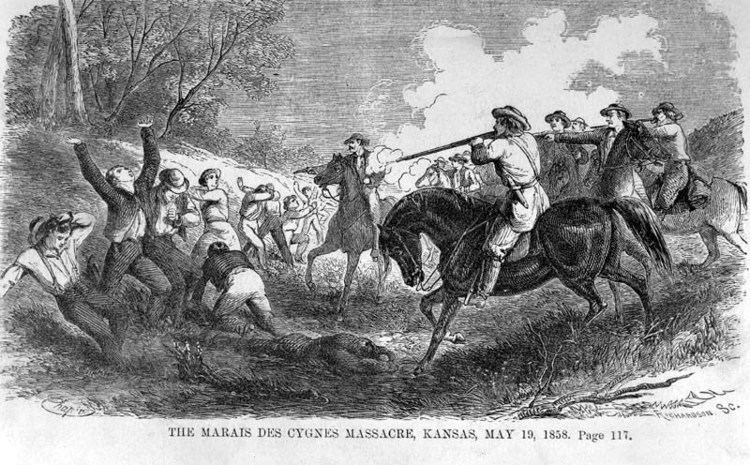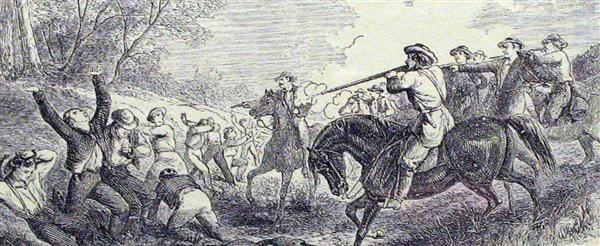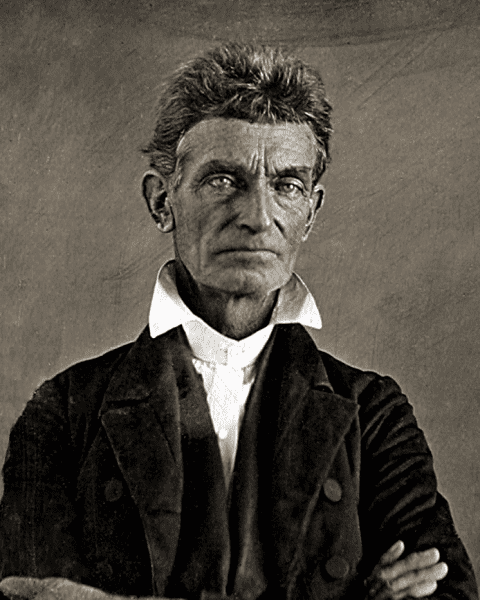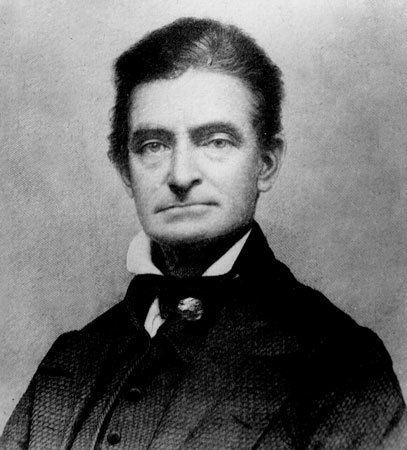Target Pro-slavery settlers Dates 24 May 1856 – 25 May 1856 | Attack type Slashing, shooting Total number of deaths 5 | |
 | ||
Perpetrator AbolitionistsPottawatomie Rifles Similar Bleeding Kansas, Sacking of Lawrence, John Brown's raid on H, Battle of Osawatomie, Battle of Black Jack | ||
Pottawatomie massacre 8th
The Pottawatomie massacre occurred during the night of May 24 and the morning of May 25, 1856. In reaction to the sacking of Lawrence, Kansas by pro-slavery forces, John Brown and a band of abolitionist settlers—some of them members of the Pottawatomie Rifles—killed five settlers north of Pottawatomie Creek in Franklin County, Kansas. This was one of the many bloody episodes in Kansas preceding the American Civil War, which came to be known collectively as Bleeding Kansas. Bleeding Kansas was largely brought about by the Missouri Compromise and the Kansas–Nebraska Act.
Contents
- Pottawatomie massacre 8th
- Pottawatomie massacre
- Background
- Attack
- Debate over Browns role and motivation
- References

Pottawatomie massacre
Background

John Brown was particularly affected by the sacking of Lawrence, in which a sheriff-led posse destroyed two abolitionist newspaper offices, the fortified Free State Hotel, and the house of Charles Robinson, the free-state militia commander-in-chief and leader of the Free State government established in opposition to the pro-slavery Territorial Government. A Douglas County grand jury had ordered the abatement because the hotel "had been used as a fortress" and an "arsenal" the previous winter and the "seditious" newspapers were indicted because "they had urged the people to resist the enactments passed" by the territorial governor. The violence against abolitionists was accompanied by celebrations in the pro-slavery press, with writers such as Dr. John H Stringfellow of the Squatter Sovereign proclaiming that pro-slavery forces "are determined to repel this Northern invasion and make Kansas a Slave State; though our rivers should be covered with the blood of their victims and the carcasses of the Abolitionists should be so numerous in the territory as to breed disease and sickness, we will not be deterred from our purpose." Brown was outraged by both the violence of pro-slavery forces, and also by what he saw as a weak and cowardly response by the antislavery partisans and the Free State settlers, whom he described as cowards, or worse. In addition, two days before this massacre Brown learned about the caning of abolitionist Charles Sumner by Preston Brooks on the floor of Congress.
Attack

A Free State company under the command of John Brown, Jr., set out, and the Osawatomie company joined them. On the morning of May 22, 1856, they heard of the sack of Lawrence and the arrest of Deitzler, Brown, and Jenkins. However, they continued their march toward Lawrence, not knowing whether their assistance might still be needed, and encamped that night near the Ottawa Creek. They remained in the vicinity until the afternoon of May 23, at which time they decided to return home.

On May 23, Sr. selected a party to go with him on a private expedition. Captain John Brown, Jr., objected to their leaving his company, but seeing that his father was obdurate, acquiesced, telling him to "do nothing rash." The company consisted of John Brown, four of his sons—Frederick, Owen, Salmon, and Oliver—Thomas Weiner, and James Townsley (who claimed he was forced by Brown to participate in the incident), whom John had induced to carry the party in his wagon to their proposed field of operations.
They encamped that night between two deep ravines on the edge of the timber, some distance to the right of the main traveled road. There they remained unobserved until the following evening of May 24. Some time after dark, the party left their place of hiding and proceeded on their "secret expedition". Late in the evening, they called at the house of James P. Doyle and ordered him and his two adult sons, William and Drury to go with them as prisoners. (Doyle's 16-year-old son, John, who was not a member of the pro-slavery Law and Order Party, was spared after his mother pleaded for his life.) The three men were escorted by their captors out into the darkness, where Owen Brown and one of his brothers killed them with broadswords. John Brown, Sr. did not participate in the stabbing but fired a shot into the head of the fallen James Doyle to ensure he was dead.
Brown and his band then went to the house of Allen Wilkinson and ordered him out. He was slashed and stabbed to death by Henry Thompson and Theodore Winer, possibly with help from Brown's sons. From there, they crossed the Pottawatomie, and some time after midnight, forced their way into the cabin of James Harris at swordpoint. Harris had three house guests: John S. Wightman, Jerome Glanville, and William Sherman, the brother of Henry Sherman ("Dutch Henry"), a militant pro-slavery activist. Glanville and Harris were taken outside for interrogation and asked whether they had threatened Free State settlers, aided Border Ruffians from Missouri, or participated in the sack of Lawrence. Satisfied with their answers, Brown's men let Glanville and Harris return to the cabin. William Sherman was led to the edge of the creek and hacked to death with the swords by Winer, Thompson, and Brown's sons.
Having learned at Harris's cabin that "Dutch Henry", their main target in the expedition, was away from home on the prairie, they ended the expedition and returned to the ravine where they had previously encamped. They rejoined the Osawatomie company on the night of May 25.
In the two years prior to the massacre, there had been 8 killings in Kansas Territory attributable to slavery politics, and none in the vicinity of the massacre. Brown murdered five in a single night, and the massacre was the match to the powder keg that precipitated the bloodiest period in “Bleeding Kansas” history, a three-month period of retaliatory raids and battles in which 29 people died.
Debate over Brown's role and motivation
In Kansas Territory, Brown’s role in the massacre was no secret. A United States congressional committee investigating the troubles in Kansas Territory identified Brown as the chief perpetrator. Nonetheless, following John Brown's raid on Harpers Ferry, there was widespread denial of Brown’s involvement in the Eastern abolitionist press. The author of Brown’s first notable biography (James Redpath, a “journalist” who was much more a propagandist) denied Brown's presence at the murders. Only after the 1879 statement of James Townsley did the Brown sympathizers admit the truth. From that date, they focused on justifications for the massacre. A whole litany of justifications involving the provocations of the pro-slavery victims were floated: they were killed in retaliation for their hanging of a free-state man, for the murder of Brown’s brother, for the murder of one of Brown’s sons and arrest of another, for the burning of the free-state settlement at Osawatomie, and for outrages upon Brown’s wife and daughters. One by one, these excuses were debunked: there had been no hanging; while a man named Rees Perkins Brown had been a victim in the territorial violence on January 19, 1856, he was no relative of John Brown; the death of one Brown son, the arrest of another, and burning of Osawatomie were all in response to (did not pre-date) the massacre; Brown’s wife and daughters never came to Kansas. That left Brown sympathizers and supporters with the position that the massacre was in response to threats of violence by the pro-slavery victims of the massacre. Regarding those threats as justification for the massacre, Charles Robinson (free-state champion and first governor of Kansas) stated:
When it is known that such threats were as plenty as blue-berries in June, on both sides, all over the Territory, and were regarded as of no more importance than the idle wind, this indictment will hardly justify midnight assassination of all pro-slavery men, whether making threats or not... Had all men been killed in Kansas who indulged in such threats, there would have been none left to bury the dead.”
John Brown was evasive about his role in the massacre, even after he was condemned to hang for his role in Harpers Ferry and when directly questioned about the incident. However, Brown reportedly informed the party that performed the killings of his objective; according to James Townsley, Brown acted to “strike terror into the hearts of the Pro-slavery party.”
